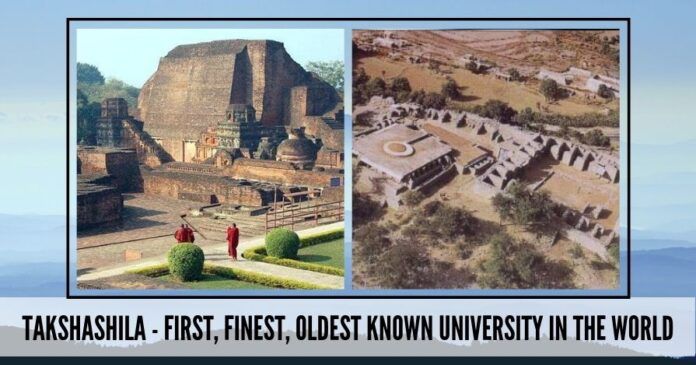
Amazing Facts About The Takshashila—Once the Knowledge Center of the World. It was the First, finest and oldest known university in the world!
1. Wondering why such name—Takshashila?
Well, Takshashila’s nomenclature was derived from King Taksha—the nephew of Lord Rama and the son of Bharata. King Taksha ruled over the region Taksha Khanda that extended from the northern fringes of India to the modern day Uzbekistan. In fact, Tashkent, the present capital of Uzbekistan, too, derives its name from the same source!
It is believed that the Mahabharata was first recited at Takṣaśilā by Vaisampayana, a student of Vyasa at the behest of the seer Vyasa himself.
No matter whether you ever liked your history classes or not, this is one name that you can never forget!
2. The Takshashila, or Taxila as it is better known, was the finest educational institute of its time. It continued for hundreds of years and yes…
It was in the land of Hindus.
The university was a hub of over 10,000 students swarming in from different parts of the world to garner knowledge and education.
3. If you think that different departments along with numerous specialization courses are the brainchild of a modern sensibility, it’s time you change your notion!
Well, 2700 years ago, Takshashila offered courses in more than 64 different fields of studies ranging from surgery and commerce to music and dance, and from philosophy and Ayurveda to grammar, politics, archery, and warfare. What’s more is that courses were taught to discover hidden treasures and decrypting messages, too! Isn’t that just wonderful?!
4. Like every modern seat of knowledge and education, you would need to complete your basic schooling, and be of 16 years, before applying for courses in here.
5. The admission process was also quite stringent and was purely based on merit. And, the competition would be among eligible students across the whole continent. So, you thought, getting through the IITs and IIMs are the only big deals, right?
Even historical records show that this institute admitted all as equals; no caste, creed or religion-based discrimination.
6. Yes; like all “modern” universities, Takshashila, too, provided you with ample choices as “electives”.
In fact, the students had to choose their electives first, and then carry on with in-depth research into the subject of their choice and preference.
7. Located in present-day Pakistan, if you are wondering if the University actually had eminent scholars, you would be surprised to look at names of a few eminent scholars that the University had just for you—
Chanakya
No matter whether you ever liked your history classes or not, this is one name that you can never forget! One of the finest political masters and the prime minister of the Mauryan Empire, Chanakya or Kautilya authored the famous Arthashastra—a compilation of 15 books that is undoubtedly one of the oldest yet finest works on economic policies, statecraft, political duties, military strategies, administrative skills, and state intelligence system.
According to the legends, Vishnu Sharma wrote Panchatantra to educate three dumb princes of a king into great political leaders within a span of 6 months!
In fact, he has been hailed as the third best management counsels in the history of India after Lord Krishna himself and Shakuni and was the prime support behind the establishment of the famous Mauryan Empire.
Panini
If Chanakya had been a stalwart in politics; Panini was the master of grammar and languages. In fact, Panini’s Ashtadhyayi is regarded as one of the most profound, if complicated, work on grammar ever. It provides a highly technical perspective on Sanskrit grammar and illustrates all the nuances, rules and features to perfection. His theory of morphological analysis was more advanced than any equivalent Western theory before the mid 20th century and his analysis of noun compounds still forms the basis of modern linguistic theories of compounding, which have borrowed Sanskrit terms such as bahuvrihi and dvandva.
Vishnu Sharma
Who hasn’t read and admired the tales from Panchatantra during the childhood days? Well, the famous author behind those simple yet admirable tales was, too, a student of Takshashila. After all, not everyone can teach the important and difficult art of political science through simple and loving tales!
According to the legends, Vishnu Sharma wrote Panchatantra to educate three dumb princes of a king into great political leaders within a span of 6 months!
Charaka
A physician who fails to enter the body of a patient with the lamp of knowledge and understanding can never treat diseases. This is what the famous author of Charaka Samhita had to say regarding the power of a good physician. Needless to say, Charaka was one of the most well-known Ayurveda physicians ever and had authored Charaka Samhita which, along with Sushrutha Samhita, Ashtanga Sangraha and Ashtanga Hrudayam, forms the crux of modern-day Ayurveda.
Jivak
Now, here’s is a man who could tell the physical problems of a body by just reading the pulse rate! After having studied at the University for 7 years and specializing in surgery, Marma and Panchakarma, Jivak had also invented a treatment for Filariasis back in those days. Being the personal physician of Lord Buddha, he also cured the Nandi Vran of Buddha. The beautiful Amrapali retained her youthful countenance and beauty thanks to the numerous surgeries and Marma points performed by Jivak on her. And, you thought cosmetic surgery is a thing of today?
It is sad that today’s generation does not know how advanced we were and the world used to come and learn from us.
Takshashila University was attacked and plundered and its books were burnt, Priests (Teachers) were killed by Huns.
The decline of Taksashila marked the destruction, persecution, and decline in Indian education, thought, and structure.
Note:
1. The views expressed here are those of the author and do not necessarily represent or reflect the views of PGurus.
- Supreme Court rejects plea to tally all VVPAT slips with EVM votes; says ‘no going back to paper ballot’ - April 26, 2024
- US report citing human rights violations is deeply biased: India - April 25, 2024
- Kotak Mahindra Bank shares tank 13%. Market Cap erodes by Rs.37,721 cr post-RBI action - April 25, 2024









I wonder why Indian history books did not teach about Takshashilla sufficiently, if at all.
Something is wrong about Indian history books, and need to be corrected.
R.Shamasastry rediscovered Arthasastra and wrote it in english too..